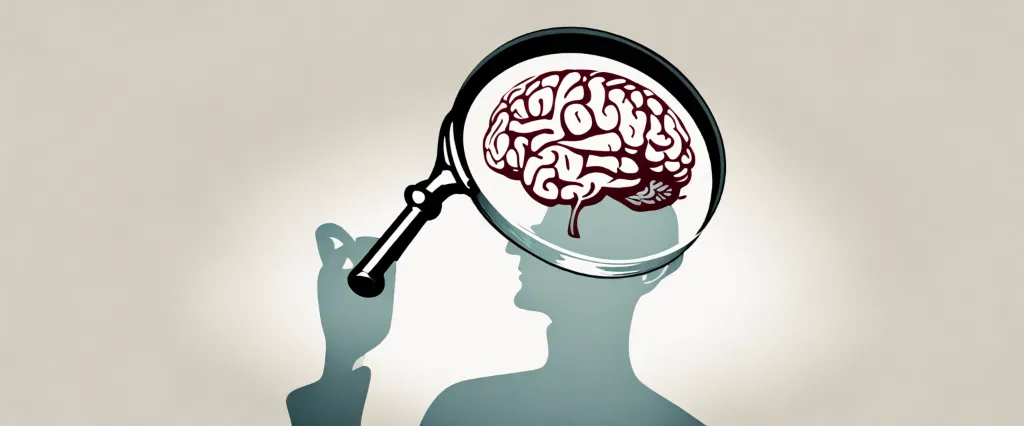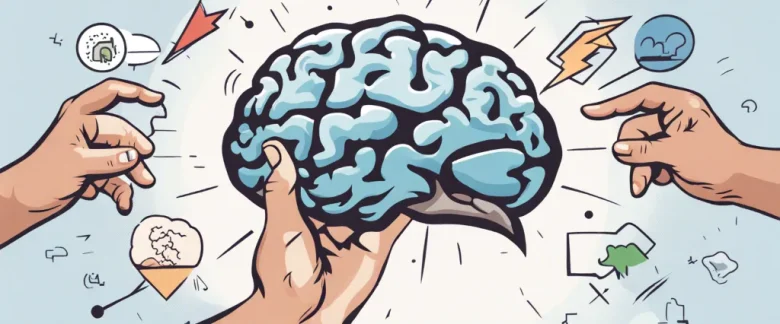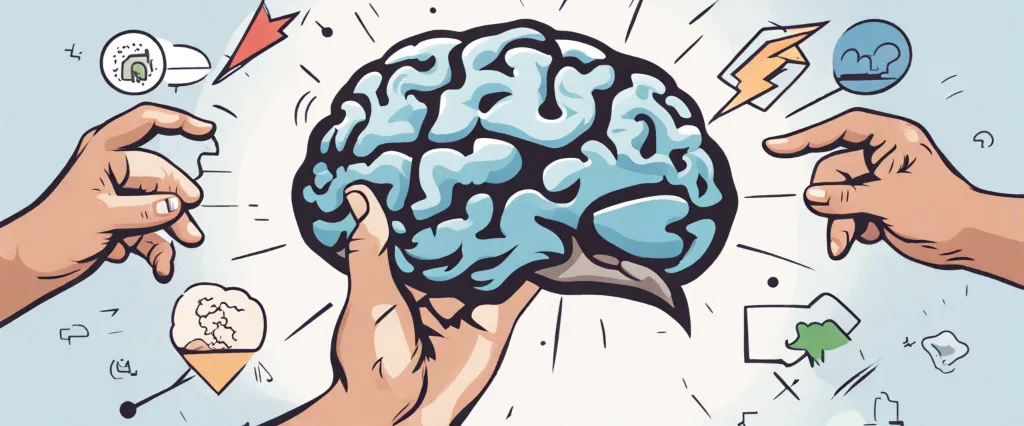In the captivating book “You Are Not So Smart,” David McRaney skillfully unveils the fascinating illusions and biases that our minds are prone to. By delving into the fields of psychology and neuroscience, McRaney explores our misconceptions and reveals how our self-delusions shape our decisions, relationships, and perceptions of the world. As a journalist and psychology enthusiast, McRaney combines his passion for storytelling with scientific research to help readers unravel the complexities of their own minds and recognize the astonishing level of self-deception that surrounds us daily. Through an engaging and enlightening journey, McRaney empowers readers to question their assumptions, challenge their beliefs, and ultimately gain a deeper understanding of human behavior.
Chapter 1: Cognitive Biases – Exploring the various cognitive biases that affect our thinking and decision-making.
Chapter 1 of “You Are Not So Smart” by David McRaney delves into the exploration of cognitive biases and their influence on our thinking and decision-making processes. The author presents numerous examples and studies, compellingly illustrating the prevalence and impact of these biases.
McRaney explains that cognitive biases are mental shortcuts or heuristics, which, although they often offer efficiency and convenience, can lead to flawed reasoning and judgement. One prominent example is confirmation bias, where individuals seek out and prioritize information that aligns with their existing beliefs, while dismissing contradictory evidence. This bias can easily reinforce preconceived notions and hinder any meaningful engagement with opposing viewpoints.
Another cognitive bias discussed is the halo effect, whereby a person’s overall impression of a particular quality influences their perception of other attributes. For instance, an attractive person may be perceived to possess more positive traits than someone deemed less attractive, without any rational basis. This bias can greatly impact decision-making, as it leads to biases in hiring, promotion, and even relationships.
The chapter also explores biases such as hindsight bias, availability bias, and the bias blind spot, among others. The hindsight bias refers to the tendency to believe that an event was easily predictable or that one’s own foresight was much greater than it actually was. Availability bias, on the other hand, occurs when individuals rely on easily available examples or memories to make judgments about likelihood or prevalence, often neglecting to consider more accurate statistical evidence.
The bias blind spot is an intriguing concept, as it suggests that while we readily acknowledge the prevalence of biases in others, we tend to remain oblivious to our own biases. This self-awareness gap often leads to overconfidence and a false sense of objectivity in our decision-making.
In conclusion, this chapter serves as an eye-opening introduction to the array of cognitive biases that pervade our thinking. By presenting compelling evidence, McRaney emphasizes the importance of recognizing and mitigating these biases to make more informed decisions, highlighting the need for critical thinking and an openness to challenging our own beliefs.
Chapter 2: Confirmation Bias – Examining the tendency to seek out information that confirms our existing beliefs and ignore contradictory evidence.
Chapter 2 of “You Are Not So Smart” by David McRaney explores the concept of confirmation bias, which is the tendency we have to seek out information that confirms our preexisting beliefs and to ignore or dismiss contradictory evidence. This chapter delves into the various ways in which confirmation bias influences our thinking and decision-making processes.
McRaney begins by explaining that confirmation bias stems from our desire for cognitive consistency. We prefer to maintain beliefs that align with our existing worldview, as it provides a sense of stability and reduces cognitive dissonance. To achieve this, we actively filter out information that challenges our beliefs and instead seek out sources that reinforce them. This tendency can significantly impact our perception of reality, leading us to become more entrenched in our beliefs and less open to alternative viewpoints.
The chapter provides numerous examples of confirmation bias in daily life, such as in politics, religion, and personal relationships. McRaney discusses how confirmation bias can contribute to echo chambers, where people surround themselves with like-minded individuals who reinforce their beliefs, further perpetuating confirmation bias. He also explores the phenomenon of “myside bias,” where individuals are more critical of evidence that contradicts their position while readily accepting evidence that supports it.
Additionally, the chapter explores strategies to counter confirmation bias. McRaney suggests seeking out diverse perspectives, engaging in self-reflection, and actively challenging one’s beliefs. These practices can help individuals develop a more accurate and nuanced understanding of complex issues and reduce the impact of confirmation bias on their decision-making processes.
In summary, Chapter 2 of “You Are Not So Smart” emphasizes the pervasive and influential nature of confirmation bias. By understanding this cognitive bias and actively combating its effects, individuals can strive for a more open-minded and balanced perspective, leading to improved decision-making and a deeper understanding of the world around them.
Chapter 3: The Illusion of Control – Discussing how we often overestimate our control over outcomes and underestimate the role of chance and randomness.
Chapter 3: “The Illusion of Control” from the book “You Are Not So Smart” by David McRaney explores the human tendency to overestimate our control over outcomes and underestimate the role of chance and randomness in our lives.
The chapter begins by discussing research on gambling, which demonstrates that individuals often believe they have more control over the outcome than they actually do. People tend to think they can influence the roll of dice or the spin of a roulette wheel through personal rituals or superstition, despite knowing that these actions have no statistical influence. This illusion of control is often driven by a desire to feel more agency and reduce anxiety in uncertain situations.
The author then explores the psychological concept of “illusion of control” and explains how it applies to various aspects of our lives. Whether it is in choosing lottery numbers or making decisions in everyday situations, we tend to believe we have more control than we actually do. McRaney highlights experiments and studies that provide evidence showing that our sense of control is often a fiction.
The chapter also discusses the role of randomness and chance in shaping outcomes. It challenges the commonly-held notion that success is solely a result of personal effort and intelligence, emphasizing the significance of uncontrollable external factors. The author presents compelling examples from sports, politics, and business realms to demonstrate how luck and chance play a considerable role in achieving success.
Overall, Chapter 3 highlights the cognitive bias of overestimating personal control and underestimating the influence of randomness. It prompts readers to reconsider their perceptions of control and recognize the complexities of external factors that shape outcomes. By understanding the illusion of control, we can more accurately evaluate and navigate the uncertainties of life.
Chapter 4: Self-Justification – Analyzing our tendency to rationalize and defend our actions, even when they are irrational or harmful.

Chapter 4 of “You Are Not So Smart” by David McRaney explores the human tendency to engage in self-justification, whereby individuals rationalize and defend their actions, despite them being irrational or harmful. This cognitive bias affects our behavior, influencing decision-making processes and shaping our understanding of ourselves and the world around us.
The chapter begins by highlighting the concept of cognitive dissonance, which refers to the discomfort that arises when our beliefs or attitudes conflict with our behaviors. To alleviate this discomfort, we tend to seek consistency between our actions and beliefs, often by distorting our perceptions or selectively interpreting information.
McRaney delves into various experiments and psychological studies that demonstrate how individuals employ self-justification to protect their egos and maintain a positive self-image. For instance, the chapter discusses Leon Festinger’s famous study on a doomsday cult that predicted the end of the world. When their prophecy failed, the cult members found ways to justify their beliefs and actions, rather than facing the incongruity between their predictions and reality.
The author also explores the phenomenon of confirmation bias, which leads individuals to seek out information that supports their existing beliefs, and selectively ignore or dismiss contradictory evidence. This bias further perpetuates self-justification, as people become trapped in an echo chamber of reinforcement.
Furthermore, the chapter sheds light on how self-justification manifests in various aspects of our lives, such as relationships, politics, and consumer behavior. It delves into topics like the “Backfire Effect,” where individuals become more entrenched in their beliefs when presented with evidence counter to their views, and the role of “choice-supportive bias” in post-purchase rationalization.
Ultimately, Chapter 4 of “You Are Not So Smart” emphasizes the universal human tendency to justify and defend our actions, even when they are illogical, harmful, or conflicting with reality. By recognizing these biases, we can strive to make more informed decisions, challenge our self-justifications, and improve our understanding of ourselves and the world.
Chapter 5: The Availability Heuristic – Investigating how our judgments and decisions are influenced by the ease with which examples or instances come to mind.
Chapter 5 of the book “You Are Not So Smart” by David McRaney focuses on the availability heuristic, which refers to a mental shortcut used by individuals to make judgments and decisions based on the ease with which examples or instances come to mind. The chapter delves into how this powerful cognitive bias affects our thinking and can lead to errors in judgment.
The availability heuristic works by relying on our memory and how easily we can recall certain information or experiences. When something is readily available in our minds, we tend to perceive it as more common or likely to happen. For example, if we can quickly recall vivid stories of shark attacks, we might overestimate the frequency of such incidents and develop an irrational fear of swimming in the ocean.
McRaney explains that the availability heuristic is shaped by several factors. One crucial factor is media exposure, as the news often amplifies negative events, making them more salient and memorable. As a result, we may overestimate the occurrence of rare but highly publicized events, such as airplane crashes, while underestimating more common but less memorable occurrences, such as car accidents.
The chapter also discusses how personal experiences and anecdotes can heavily influence our judgments. We tend to rely on our own experiences or anecdotes shared by others when making decisions, even if they may not accurately represent the whole picture. For example, if someone we know has had a negative experience with a particular brand, we may avoid it, assuming that all their products are of poor quality.
Furthermore, the availability heuristic can lead to biases in various domains, including medical diagnoses, financial decisions, and risk assessments. By understanding this cognitive bias, we can actively challenge our default thinking patterns and make more rational judgments. McRaney highlights the importance of gathering reliable data, seeking a balance of information, and being aware of the biases that influence our decision-making.
Overall, Chapter 5 of “You Are Not So Smart” emphasizes how the availability heuristic shapes our perceptions and judgments, showing the potential pitfalls of relying solely on easily accessible information. By recognizing and mitigating this bias, we can make more informed and rational decisions in various aspects of our lives.
Chapter 6: The Power of Stories – Exploring how narratives shape our perceptions, beliefs, and behaviors.
Chapter 6 of “You Are Not So Smart” by David McRaney explores the power of stories and how they shape our perceptions, beliefs, and behaviors. The chapter delves into the psychological reasons behind our love for narratives and their immense influence on our lives.
McRaney begins by explaining that our brains are wired to process information in the form of stories. Our ancestors relied on storytelling to transfer knowledge and survival skills from one generation to the next. This evolutionary advantage has ingrained a strong affinity for narratives in our brains.
The author then highlights how stories have the power to shape our beliefs. Through confirmation bias, we tend to seek out stories that align with our existing beliefs and values. Stories that challenge our worldview are often disregarded or dismissed, which reinforces our preconceived notions.
Furthermore, stories influence our behavior by framing situations and offering solutions. McRaney emphasizes that stories can manipulate our emotions and decision-making processes. Advertisers, politicians, and marketers have long understood the power of stories in shaping our purchasing choices and political beliefs.
The chapter also addresses the concept of narrative fallacy, which refers to our inclination to infer causality and patterns where there might be none. McRaney highlights the danger of blindly accepting stories without critically evaluating the evidence supporting them.
In conclusion, Chapter 6 of “You Are Not So Smart” explores how narratives have a profound impact on our perceptions, beliefs, and behaviors. Our brains are wired to process information in the form of stories, making them a powerful tool for shaping our worldview. Understanding the influence of narratives can help us become more aware of our biases and make more informed decisions.
Chapter 7: Social Proof – Discussing the influence of social influence and conformity on our thoughts and actions.
Chapter 7 of “You Are Not So Smart” by David McRaney delves into the concept of social proof and its impact on our thoughts and actions. Social proof refers to the tendency for people to rely on the actions and beliefs of others to determine what is correct or appropriate in a given situation.
The chapter begins by describing a series of social psychology experiments which highlight the power of conformity. These studies, such as Asch’s line experiments and Milgram’s obedience experiments, demonstrated how people are inclined to adopt the opinions and behaviors of others, even when they conflict with their own perceptions or morals. This desire to conform arises from the need for social acceptance and the fear of rejection or conflict.
The concept of social proof extends to various areas of our lives, including consumer behavior and decision-making. Advertisers deliberately utilize social proof to influence our choices by highlighting how popular or widely endorsed a product or service is. We tend to believe that if many others have chosen something, it must be valuable or correct.
The chapter also addresses social media and the impact of the online world on social proof. Likes, shares, and comments on platforms such as Facebook and Instagram serve as visible forms of social proof. We often gauge our popularity and self-worth based on these metrics, further solidifying the influence of social proof in our lives.
However, McRaney emphasizes that social proof is not always reliable and can lead us astray. It can perpetuate misinformation, reinforce harmful behaviors, and hinder progress. Being aware of and questioning our susceptibility to social proof is essential to making more informed decisions and maintaining individuality in a world driven by conformity.
In conclusion, Chapter 7 of “You Are Not So Smart” explores the powerful impact of social proof on our thoughts and actions. It highlights our innate tendency to conform and rely on the beliefs and behaviors of others. Understanding the role of social proof in various aspects of our lives is crucial for making more independent and informed choices.

Chapter 8: The Future is Now – Examining our bias towards immediate gratification and the challenges of long-term thinking and planning.
Chapter 8 of “You Are Not So Smart” by David McRaney focuses on our bias towards immediate gratification and the challenges of long-term thinking and planning.
McRaney begins by explaining that humans have evolved to be driven by immediate rewards. Our ancestors who successfully sought immediate gratification in the form of food or other necessities were more likely to survive and pass on their genes. However, in modern society, this bias towards immediate rewards can lead to various problems.
One aspect of this bias is present bias, where we tend to prioritize short-term gains over long-term benefits. The author explores various examples, such as procrastination, impulsive spending, and addictive behaviors. These tendencies are consequences of our brain’s preference for immediate rewards.
Moreover, McRaney discusses the challenges of long-term thinking and planning. This involves resisting temptations and delaying gratification for bigger rewards in the future. He explains how our brains struggle with this concept due to the contrasting motivations of our impulsive, present-focused system and our more rational, future-oriented system.
To illustrate his points, the author presents several studies and experiments that shed light on our biases and decision-making processes. He examines the role of self-control, willpower, and the consequences of failing to consider the long-term implications of our actions.
In conclusion, Chapter 8 emphasizes the conflict between our instinctive desire for immediate gratification and the importance of long-term thinking. While our brains are wired to prioritize instant rewards, being aware of this bias can help us make more intelligent decisions and improve our ability to plan for the future.
After Reading
In conclusion, “You Are Not So Smart” by David McRaney effectively explores the various cognitive biases and illusions that shape our thinking and decision-making processes. Through engaging anecdotes and scientific research, McRaney highlights the profound impact these biases have on our everyday lives, from our opinions and beliefs to our relationships and behavior. He urges readers to become aware of their own fallibility, to embrace uncertainty, and to question their own thoughts and assumptions. By exposing the many ways in which our minds deceive us, McRaney empowers us to navigate the complexities of the modern world with a more critical and rational approach.
1. Thinking, Fast and Slow” by Daniel Kahneman – This book explores the two systems of thinking that influence our decision-making process, providing insights into our biases and fallacies.
2. Mistakes Were Made (But Not by Me)” by Carol Tavris and Elliot Aronson – Investigating cognitive dissonance, this book explores how self-justification can lead to misunderstandings, mistakes, and the avoidance of responsibility.
3. Predictably Irrational” by Dan Ariely – Uncovering the irrational forces that shape our decisions, this book delves into the hidden motivations behind our behaviors and the ways in which we can be easily influenced.
4. “The Invisible Gorilla: And Other Ways Our Intuitions Deceive Us” by Christopher Chabris and Daniel Simons – Addressing the limitations of human perception and memory, this book highlights the various ways in which our intuition can lead us astray.
5. The Art of Thinking Clearly” by Rolf Dobelli – Presenting a collection of cognitive biases and logical fallacies, this book offers practical advice on how to cultivate better decision-making skills and avoid common mental pitfalls.




